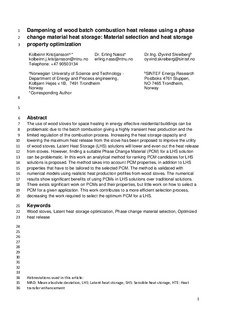| dc.contributor.author | Kristjansson, Kolbeinn Jakob | |
| dc.contributor.author | Næss, Erling | |
| dc.contributor.author | Skreiberg, Øyvind | |
| dc.date.accessioned | 2017-12-11T09:35:48Z | |
| dc.date.available | 2017-12-11T09:35:48Z | |
| dc.date.created | 2016-08-20T13:30:33Z | |
| dc.date.issued | 2016 | |
| dc.identifier.citation | Energy. 2016, 115 (1), 378-385. | nb_NO |
| dc.identifier.issn | 0360-5442 | |
| dc.identifier.uri | http://hdl.handle.net/11250/2469915 | |
| dc.description.abstract | The use of wood stoves for space heating in energy effective residential buildings can be problematic due to the batch combustion giving a highly transient heat production and the limited regulation of the combustion process. Increasing the heat storage capacity and lowering the maximum heat release from the stove has been proposed to improve the utility of wood stoves. Latent Heat Storage (LHS) solutions will lower and even out the heat release from stoves. However, finding a suitable Phase Change Material (PCM) for a LHS solution can be problematic. In this work an analytical method for ranking PCM candidates for LHS solutions is proposed. The method takes into account PCM properties, in addition to LHS properties that have to be tailored to the selected PCM. The method is validated with numerical models using realistic heat production profiles from wood stoves. The numerical results show significant benefits of using PCMs in LHS solutions over traditional solutions. There exists significant work on PCMs and their properties, but little work on how to select a PCM for a given application. This work contributes to a more efficient selection process, decreasing the work required to select the optimum PCM for a LHS. | nb_NO |
| dc.language.iso | eng | nb_NO |
| dc.publisher | Elsevier | nb_NO |
| dc.rights | Attribution-NonCommercial-NoDerivatives 4.0 Internasjonal | * |
| dc.rights.uri | http://creativecommons.org/licenses/by-nc-nd/4.0/deed.no | * |
| dc.title | Dampening of wood batch combustion heat release using a phase change material heat storage: Material selection and heat storage property optimization | nb_NO |
| dc.type | Journal article | nb_NO |
| dc.type | Peer reviewed | nb_NO |
| dc.description.version | acceptedVersion | nb_NO |
| dc.source.pagenumber | 378-385 | nb_NO |
| dc.source.volume | 115 | nb_NO |
| dc.source.journal | Energy | nb_NO |
| dc.source.issue | 1 | nb_NO |
| dc.identifier.doi | 10.1016/j.energy.2016.08.071 | |
| dc.identifier.cristin | 1374255 | |
| dc.relation.project | Norges forskningsråd: 243752 | nb_NO |
| dc.relation.project | Norges forskningsråd: 193817 | nb_NO |
| dc.description.localcode | This is the authors' accepted and refereed manuscript to the article. Locked until 13 September 2018 due to copyright restrictions | nb_NO |
| cristin.unitcode | 194,64,25,0 | |
| cristin.unitname | Institutt for energi- og prosessteknikk | |
| cristin.ispublished | true | |
| cristin.fulltext | original | |
| cristin.fulltext | postprint | |
| cristin.qualitycode | 2 | |

